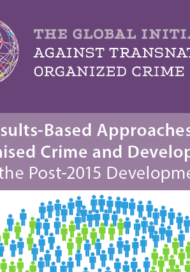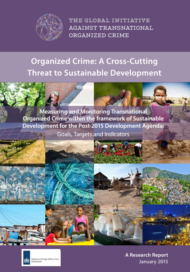Posted on 22 Apr 2015
In a recent publication, “Organized Crime as a Cross-Cutting Threat to Development” the Global Initiative proved that the organized crime severely impacts the international community’s capacity to achieve basic social and economic development objectives and erodes long-term development potential. The study gave evidence that the effects of organized crime are being felt in fragile, developing, middle-income and developed nations alike. Organized crime denigrates communities and societal structures, the environment and the economy, undercutting the ability to build state institutions and deliver services to the people.
In recognising the significant and enduring negative impacts organized crime has on development, the adoption of the Sustainable Development Goals (SDGs) is a key opportunity to empower development actors and charge them with the mandate to mitigate the impact of organize crime on development. The adoption of the SDGs provides a discussion platform to not only sensitize development actors to the impact organized crime has on development objectives, but to also equip them with the tools and knowledge to identify when and how organized crime affects the achievement of their goals.
The objective of this technical note, “Results-based approaches to Organized Crime and Development,” is to enhance the capacity of development actors to recognise and respond to the negative impacts of transnational organized crime in a results-based manner. It has been prepared and released to inform the deliberations around the post-2015 agenda, in particular the work that will be done to establish indicators to monitor progress against the goals and targets once they are established. The note, however, is designed to have a much broader application and greater longevity.
The analysis identified five development impact areas as the spheres in which organized crime arguably does the most damage to development:
This project by the Global Initiative against Transnational Organized Crime intends to fill these gaps and align research on this area with on-going processes and multilateral discussions on the new framework for the Sustainable Development Goals.
The report provides a set of results-based matrices, including outcomes, outputs and indicators, with associated datasets, that could be used to inform approaches to organized crime in a development setting. In some cases, the approach requires directly addressing the organized crime itself, in other cases, it requires putting in place measures to counter the negative externalities of organized crime, protecting and building the resilience of the most vulnerable.
The complexity of responding to organized crime requires a holistic, human rights-based response that is both broad enough to address the problem on multiple levels and specific enough to make sense in the local context. As organized criminal flows frequently cross national borders, there are some interventions required at the international level, there are, however, also a significant number of interventions required by national governments to protect citizens and strengthen capacities to address criminal acts within their own national borders. Successful interventions will furthermore require multi-sectoral partnerships, engaging with non-state actors in the private sector and civil society. In each case, identifying the local context and the specific mechanisms of organized crime that are taking place within a country is essential to creating a strategic response. As such, in the results matrices to follow, the actors who are required to be engaged in the response are indicated.
The Global Initiative invites all development practitioners and policy makers, as well as interested analysts to download, use and circulate this tool. Any feedback is also most appreciated.





